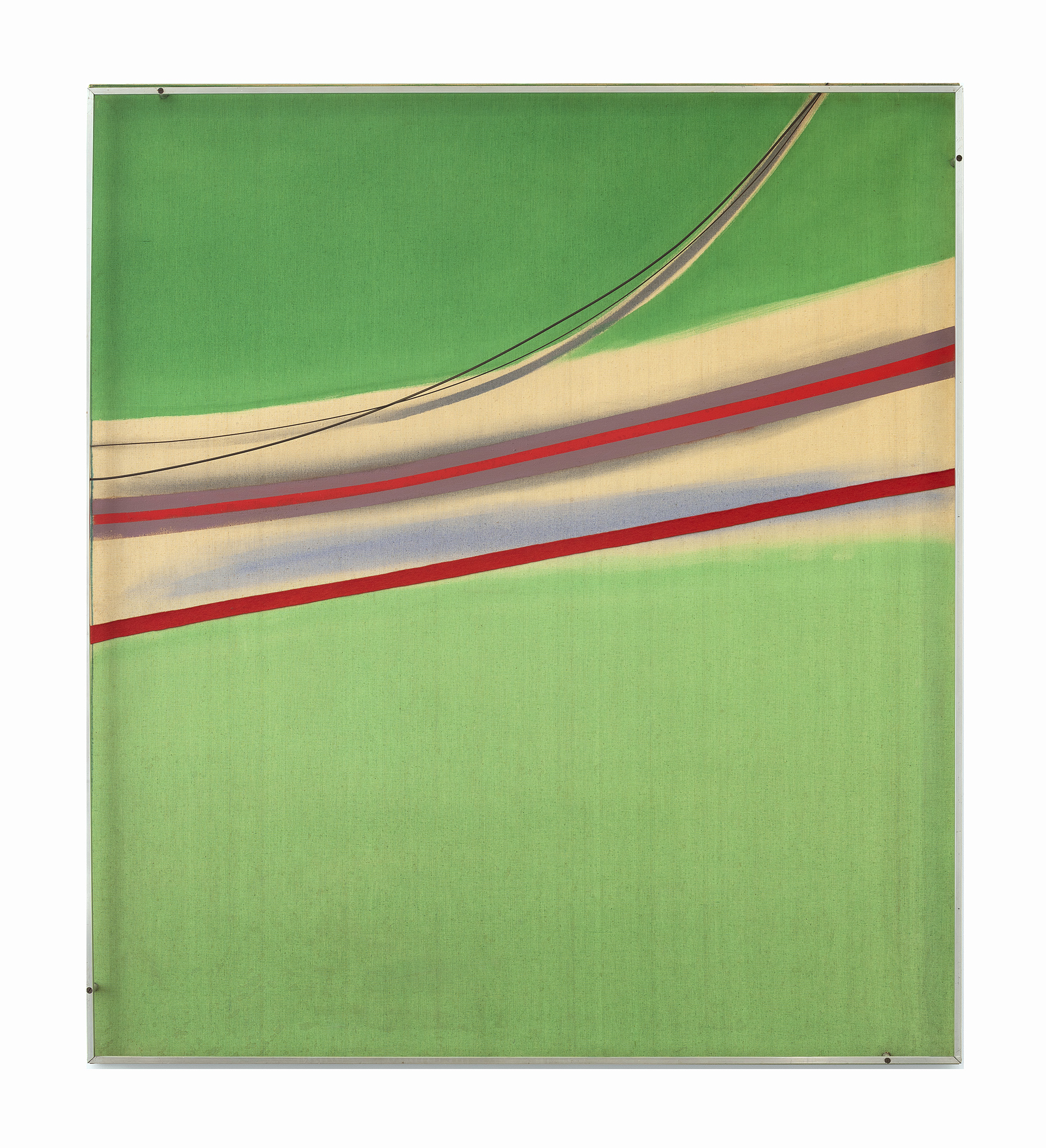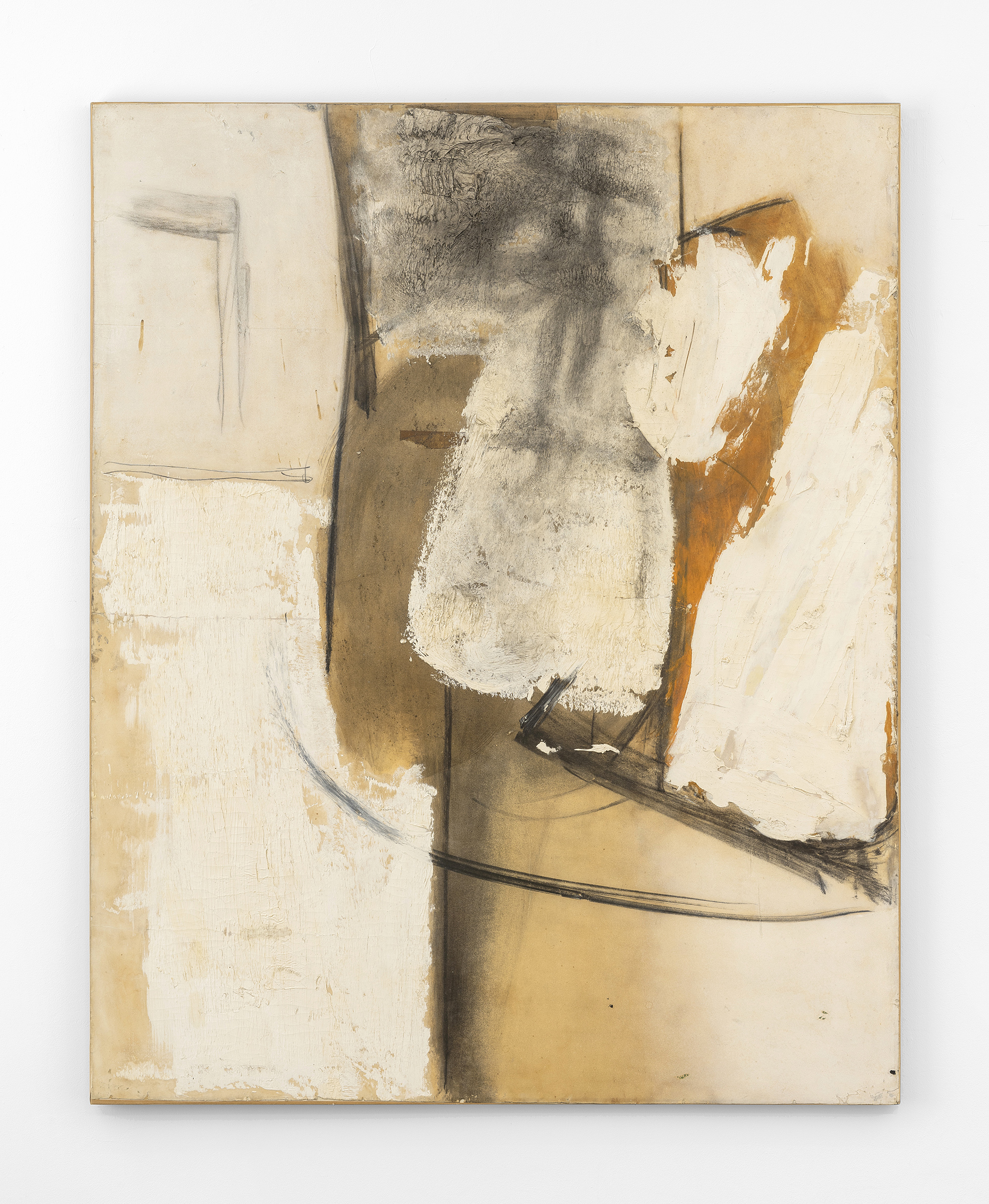
Sandra Blow, Green Projection, 1971
Sandra Blow: Early Works charts Sandra Blow’s early experiments with gesture and material abstraction from 1959 through 1973. These first few decades defined Blow’s artistic production as one which probed pictorial space and colour, questioning the very tenets of production within the artistic sphere. Her emphasis on form and preoccupation with process, intention and composition, are testament to her position as one of the boldest voices in British Abstraction since the inception of the movement.
As was the case throughout her career, Blow took inspiration from disparate artistic movements and consequently her practice resists identification with one single group or style. Although much of her early career was spent in London, Blow’s working practice was crucially shaped by a tour of Italy in the late 1940s and time spent in Cornwall.
From 1947 – 48, Blow spent a year travelling in Italy. In Rome she met several Italian abstract painters; notably Nicholas Carone, who had been a student of Hans Hofmann in New York, and Alberto Burri. With Burri, Blow formed a romantic, as well as professional, relationship. He was associated with ‘Art Informel’ or ‘art autre’ – a radical style of abstract painting of the 1940s and ‘50s characterised by an informal and experimental approach. The assumption that their theoretical and methodological exchange was dominated by the older and more established Burri is now being questioned. Although Blow’s work was profoundly influenced by Burri – indeed she described his work as being linked to her own ‘like an umbilical cord’ – she did not merely take on an adaptation of his style. Blow’s interest in abstract painting was just as significantly inspired by Carone. In a 1996 interview, she recounts how, through conversations with Carone, she had a significant realisation;
‘He was talking to me about his paintings, and suddenly I saw what he was talking about; he was talking about spatial movements in paintings. And I suddenly saw that one patch of colour was doing something to another. It just came clear to me.’
Spatial movements and the relations between areas of tonality would become a defining feature of Blow’s work. The artist’s early work, particularly, is defined by an interest in space and balance, tension and harmony. There were other aspects of the Italian tour that had significant formative influence, aside from Burri’s work. She was fascinated, too, with the tensions between materials, with the symmetry and spatial formation that she saw in classical architecture. This interest in structural balance is one aspect that sets her work apart from her contemporaries. Exposure to the early Renaissance frescoes of Piero Della Francesca, Giotto and Masaccio, also had a resounding influence. Blow did not attempt abstract painting during her stay in Italy. She was determined to take abstraction back to London, and there to develop a style of her own. This was a deliberate personal and professional break with Burri. Blow would continue to use techniques associated with Art Informel, including gestural abstraction and the incorporation of raw and unorthodox materials such as cement, clay, plaster and wire. In particular, the use of sacking in Blow’s work came directly from Burri’s own practice. Yet, she soon acknowledged a ‘formation’ in her use of these materials that was distinct from Burri’s and would go on to develop a unique and original style of work. The use of tactile materials offered a new spatial presence to Blow’s canvases, and allowed for the potential of a physical dimension to her spatial explorations.
While ‘Art Informel’ is traditionally associated with Automatism, the technique of painting or drawing through ‘automatic’ gestures and free association, and often explores experimentation, Blow would carefully work through a considered composition. She would envision several iterations of a composition before committing it to canvas, and would repeatedly return to a canvas over long periods until she felt a work had achieved the balance that she strived for. From this careful process, the resulting works have a depth and structural grounding that seems at odds with Art Informel’s commitment to spontaneity.
Although Blow’s process of painting was meditative and considered, she was not an isolated figure. She was a socially engaged artist and close friendships with other painters were important in her life and her work. In 1957, just as her career was taking off in London and New York, Blow was invited to Cornwall by her contemporary, British painter Patrick Heron. This was the first of two significant periods spent there, the second being 1994 – 2006. Her friendships with Heron and with Roger Hilton placed Blow in a network of artists based in West Cornwall at a time when St Ives was being recognised for its role in the development of British abstract art. Hilton was, by the time of their meeting in the early 1950s, an established exponent of post-war abstraction. Blow was to declare that ‘the only people I really have been closely connected to in painting are Roger [Hilton] and Alberto Burri.’ For his part, Hilton described Blow as a ‘heroic painter.’
The time spent in Cornwall is an arguably vital component to Blow’s career. It was in Cornwall that Blow’s use of ‘encrusted’ gesture dwindled in favour of compositions which aimed to balance geometric ‘bands’, parabolic curves, and vigorous colour. She has spoken of there being some innate ‘biological movement’ in painting, something that is reflected in the Cornish landscape and the sea. Much of Blow’s work is a reconciliation between carefully conceived structure and this movement.
Sandra Blow: Early Works includes a number of works that Blow termed her ‘Tea Paintings’, all created in the years after her return from Cornwall, mostly in the mid-1960s while she was teaching at the Royal College of Art in London. Here, she used white paint, ash, tea, and glue to explore the creative possibilities of a sparse aesthetic approach. It was these paintings that prompted critic, Norbert Lynton to declare that Blow ‘found her voice’ in the ‘60s.
Blow’s use of unconventional materials, first utilised after meeting Burri in Italy, as well as her experiments with form and pictorial space, continued into the 1970s. Two works in Sandra Blow: Early Works – Green Projection (1971) and Untitled (1973) – are examples of Blow incorporating three dimensional aluminium structures into her compositions, radically calling into question the formal parameters of the picture plane. As the 1970s dawned, the muted, earth tones of the earliest of Blow’s canvases gave way to colour. While always prioritising the structure of plastic space over colour, the introduction of brighter tones in this period derived, in part, from exposure to the intense pop art hues of the 1960s.
Blow devoted her career to investigating the ways that forms and colour interacted, particularly considering the spatial balance held between them. The canvases in Sandra Blow: Early works demonstrate how this practice defied easy categorisation, and how her process and her use of material was decidedly radical. The first two decades of Blow’s artistic career established her position as a pioneering British artist, and laid the foundation for her unique and enduring contribution to Modern British Abstraction
(By Tom Winter)
